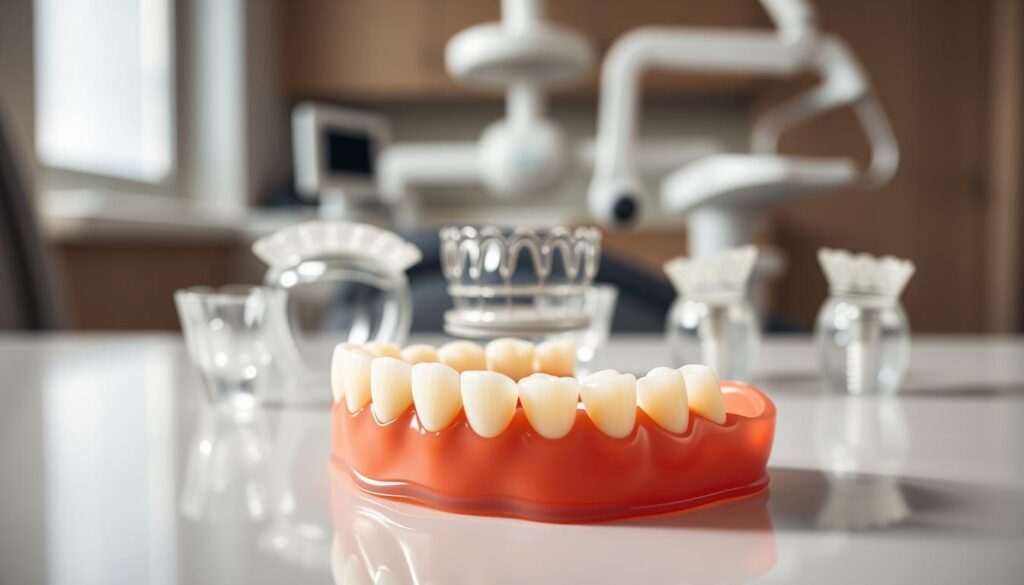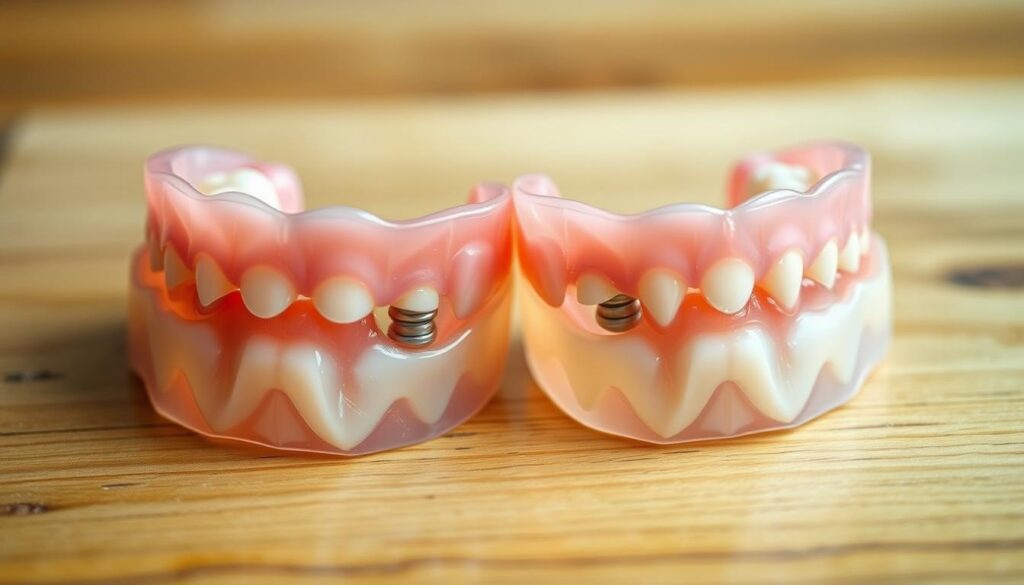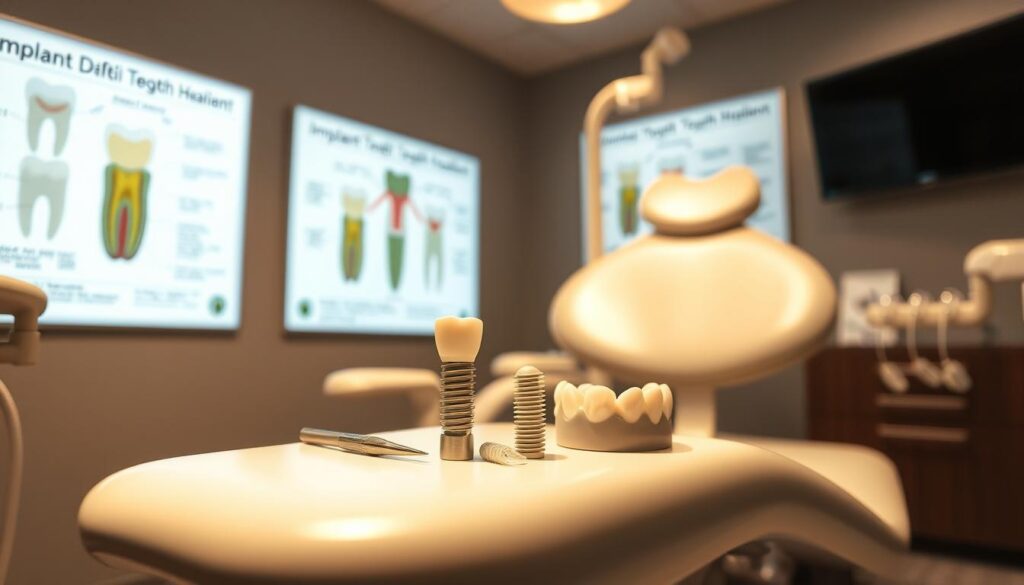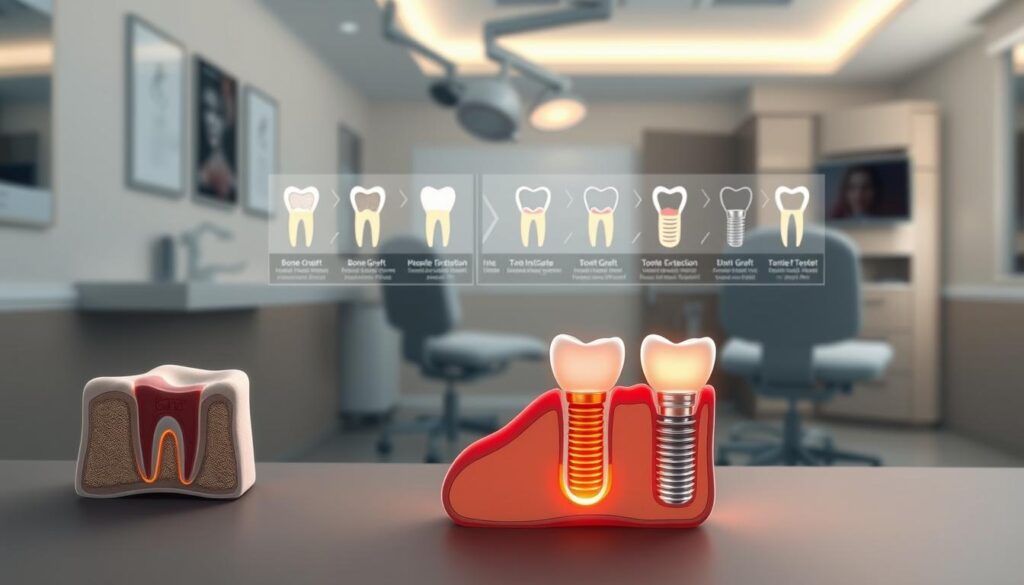Imagine replacing missing teeth without months of gaps in your smile. The fear of being toothless stops many from getting dental implants. But, modern dentistry offers ways to keep you smiling during the implant process.
Most patients don’t have to go without teeth during their journey. The osseointegration process takes 3 to 6 months. But, you won’t be toothless the whole time. Dentists give you temporary teeth to keep your smile and function.
The time without teeth varies for everyone. Some get temporary teeth the same day as surgery. Others might wait a few days or weeks. The whole treatment can last 3 to 9 months. But, you’ll have teeth most of the time.
Key Takeaways
- Most patients receive temporary teeth within days of implant surgery
- The healing process takes 3-6 months but doesn’t mean going toothless
- Same-day temporary solutions are available for many implant cases
- Multiple temporary options exist including dental flippers and temporary bridges
- The complete implant process ranges from 3-9 months depending on individual needs
- Your dentist will create a plan to minimize any time without teeth
Understanding the Dental Implant Timeline
Getting dental implants is a process with several stages. Each stage is important for a lasting tooth replacement. The whole implant surgery timeline takes a few months. Knowing what to expect helps you prepare for the journey.
Initial Consultation and Planning Phase
Your journey starts with a detailed evaluation that takes one to two weeks. Your dentist will do X-rays or 3D scans to check your bone and plan the implant’s placement. This planning is key for the best results.
Tooth Extraction and Healing Period
If you need teeth removed before implants, the healing time is six weeks to three months. Your gums and bone need time to heal. If bone grafting is needed, healing might take a bit longer.
Implant Placement Surgery
The surgery to place the implants is straightforward. Titanium posts are put into your jawbone. These posts act as roots for your new teeth. Most patients feel little pain during the procedure.
Osseointegration Process
The osseointegration process is crucial for your dental implant healing time. It takes three to six months for your bone to fuse with the titanium. This creates a strong bond, making your implants stable like natural teeth.
How Long Do You Go Without Teeth When Getting Implants?
Many people worry about the time without teeth when getting dental implants. The time needed varies based on several factors. Modern dentistry has made it possible to reduce or even eliminate this waiting period.
Factors Affecting the Duration
Several key factors determine how long you’ll be without teeth during implant treatment:
- Bone density and quality – Patients with strong jawbone may qualify for immediate load implants
- Need for bone grafting – Additional procedures extend the overall timeline
- Number of teeth being replaced – Single tooth replacements often have shorter timelines
- Overall oral health – Gum disease or infections must be treated first
- Location in the mouth – Front teeth typically receive priority for aesthetic reasons
Average Timeline for Different Cases
| Treatment Type | Time Without Teeth | Total Treatment Duration |
|---|---|---|
| Single Tooth (Front) | 0-1 day | 3-6 months |
| Single Tooth (Back) | 0-3 months | 3-6 months |
| Multiple Teeth | 0-7 days | 4-8 months |
| Full Arch | 0-2 days | 4-12 months |
Same-Day Solutions vs Traditional Timeline
Same day dental implants have changed the game. They allow for temporary teeth in the same visit as tooth extraction. Traditional implants need 3-6 months before the crown is placed.
Choosing between immediate and traditional implants depends on your situation. Your dentist will look at bone quality, infection risk, and aesthetic needs to decide the best option for you.
Immediate Load Implants and Same Day Dental Implants
For those looking for quick dental fixes, immediate dental implants are a game-changer. They let you get functional teeth in just hours, not months like old methods.
Same day tooth replacement uses a method called immediate loading. Dentists put the implant in and attach a temporary crown right there. This instant implant solution means you can leave the dentist with a full smile.
Several things decide if you can get same day tooth replacement:
- Strong jawbone density to support the implant
- Excellent overall oral health without active infections
- Non-smoking status for optimal healing
- Strategic implant location, especially beneficial for front teeth
The success of immediate dental implants depends on getting the implant stable right away. Your dentist will check the torque force needed. If it’s strong enough, you might get a temporary crown the same day.
Front teeth are often the best for this method because looks matter most there. You can keep your smile and confidence without a gap while healing.
Temporary Teeth During Implant Process
Getting dental implants doesn’t mean you have to go without teeth for months. There are many temporary dental solutions to keep your smile and function while implants heal. These temporary teeth act as placeholders, protecting the site and keeping your life quality during treatment.
Types of Temporary Restorations
Patients have many options for implant healing. Temporary dentures are great for replacing several teeth. They sit on the gums and can be used right after tooth removal.
Dental flippers are a light option for single tooth gaps. They clip onto nearby teeth, filling the space naturally. Temporary bridges use nearby teeth as anchors for a false tooth in between.

When an implant can handle weight, temporary crowns attach directly to it. These look and feel like real teeth during healing.
Benefits of Temporary Solutions
Provisional restorations for implants have big advantages:
- They keep your face looking normal and prevent sunken cheeks
- They let you speak normally without gaps affecting your speech
- They allow eating soft foods comfortably
- They protect the healing implant site from debris
- They prevent nearby teeth from shifting into empty spaces
Limitations and Care Instructions
Temporary dental solutions need special care. Avoid sticky candies, hard nuts, and chewy meats that could harm them. Clean them gently with a soft brush after meals. Remove partial dentures at night to let your gums rest.
While these options are good, they’re not as strong as permanent teeth. Biting into hard foods like apples or corn on the cob can break them. Follow the care instructions to make them last until your final crowns arrive.
Provisional Restorations for Implants
While implants heal, patients need teeth to keep up with daily life. Provisional restorations act as placeholders for the permanent teeth. These temporary crown options protect the implants and let patients eat, speak, and smile with confidence.
Custom-Made Temporary Crowns
Custom temporary crowns are great for single tooth replacements. Your dentist makes them to look like your natural teeth. But, you need to be careful with what you eat. Avoid hard foods like apples or corn on the cob because they can damage the temporary crowns.
Temporary Bridges for Multiple Teeth
Provisional bridge solutions are best for replacing several teeth at once. Unlike transitional dentures that you remove, temporary bridges stay in place. Your dentist cements them to nearby teeth or implants, helping you eat softer foods and keeping your bite right.
Snap-On Smile Options
Snap-On Smile appliances are a removable cosmetic fix during implant healing. They fit over your teeth or gums, instantly enhancing your smile. They’re easy to remove for cleaning and still look natural during social and work activities.
Transitional Dentures and Their Role
Transitional dentures are temporary denture solutions for those getting dental implants. They offer both looks and function during the healing time. This is unlike simpler options.

They are great when many teeth need to be pulled at once. Patients can keep looking good and eat many foods while their implants heal. Transitional dentures are more stable and better for chewing than basic ones.
| Feature | Transitional Dentures | Basic Flippers |
|---|---|---|
| Number of Teeth | Multiple teeth or full arch | 1-3 teeth only |
| Eating Capability | Most soft and medium foods | Limited to very soft foods |
| Adjustment Frequency | Every 2-4 weeks | Monthly or as needed |
| Durability | 6-12 months | 3-6 months |
Getting these implant healing dentures adjusted regularly is key. Your dentist will do this to keep them fitting right. This helps the dentures support your face and protect the implants while they heal.
“The right transitional denture can make the difference between hiding at home and living normally during implant treatment.”
Today, many dental clinics offer custom transitional dentures. These solutions help patients keep up with their daily lives while waiting for their implants. They make the wait easier.
Dental Flipper as a Temporary Solution
Many people choose a flipper tooth replacement after tooth extraction. It’s a light, affordable way to keep your smile while you heal. Knowing about this temporary solution helps you decide on dental care during treatment.
What Is a Dental Flipper?
A dental flipper is made of acrylic with artificial teeth. It fits against your palate or jaw, held by thin metal clasps. Unlike dentures, flippers are for short-term use and easy to remove.
Labs can make these fast, often in 24 to 48 hours. They take impressions to ensure a good fit and color. The teeth match your natural teeth for a natural look.
Pros and Cons of Dental Flippers
| Advantages | Disadvantages |
|---|---|
| Affordable cost ($300-$500) | Not suitable for hard foods |
| Quick fabrication time | May affect speech initially |
| Maintains facial structure | Requires nightly removal |
| Preserves smile appearance | Less durable than alternatives |
| Easy to clean and maintain | Can feel bulky in mouth |
Daily Care and Maintenance
Proper care extends your flipper’s life and keeps your mouth healthy. Here’s how:
- Remove and rinse after each meal
- Brush gently with soft-bristled toothbrush twice daily
- Soak overnight in denture cleaning solution
- Store in water when not wearing
- Handle carefully to prevent breakage
Regular cleaning prevents bacteria buildup and keeps your flipper tooth replacement looking natural. Most people get used to wearing it within a week. It’s comfortable for daily activities, except eating tough foods.
Maryland Bridges During Healing
A Maryland bridge is a great temporary fix for dental implants. It bonds to the teeth next to your missing one. This way, it provides a stable solution without needing to drill too much.
Unlike regular bridges, Maryland bridges don’t harm your teeth. They use a metal or porcelain frame with small wings. These wings attach to your teeth with dental cement. This makes them perfect for front teeth while you wait for implants to heal.
These bridges are better than removable ones. You can eat, talk, and smile without fear of them falling out. They stay put, giving you comfort and security while your implants heal.
| Feature | Maryland Bridge | Removable Options |
|---|---|---|
| Stability | Fixed in place | Can shift or move |
| Tooth Preparation | Minimal to none | No preparation needed |
| Cleaning Method | Brush and floss normally | Remove for cleaning |
| Speech Impact | No effect | May affect pronunciation |
Your dentist can put in a Maryland bridge in just one or two visits. They take impressions, make the bridge, and bond it. This minimally invasive approach is great for those who want comfort and looks during implant treatment.
Living Without Teeth During Implant Treatment
Waiting for dental implants requires planning and patience. Many worry about living without teeth during implant treatment. But, with the right strategies, this phase is manageable. Your dental team will help you find the best temporary tooth solutions for your lifestyle.
Daily Activities and Adjustments
Speech may change when you’re missing teeth or using temporary solutions. Practicing reading aloud can help you adjust quickly. Simple lifestyle adjustments implants require include:
- Speaking more slowly and clearly
- Using dental adhesive for removable temporaries
- Keeping spare cleaning supplies at work
- Scheduling regular adjustment appointments
Dietary Modifications
Eating habits need careful attention during healing. Soft foods are your best friends to protect surgical sites. Good options include scrambled eggs, yogurt, mashed potatoes, and smoothies. Avoid hard items like ice, nuts, and raw vegetables that could damage healing areas.
Social and Professional Considerations
Maintaining confidence during treatment is important for work and social situations. Temporary tooth management options like flippers or provisional crowns help. Many plan implant surgery around important events or quieter work periods. Talking openly with friends and family creates a support system during recovery.
Regular checkups let your dentist monitor healing progress and adjust temporary teeth as needed. Most patients successfully navigate this period by focusing on the long-term benefits of their new smile.
Tooth Replacement Options During Implant Healing
Waiting for dental implants to heal doesn’t mean you can’t smile. There are many ways to replace teeth while your jawbone heals. Each option has its own benefits, depending on what you need and how you live.
Essix Retainers
Essix retainer implants are a nearly invisible fix. They fit over your teeth and hold a fake tooth in place. People like them because they’re:
- Completely removable for easy cleaning
- Crystal clear and barely noticeable
- Comfortable for speaking and eating soft foods
- Affordable compared to other temporary options

Removable Partial Dentures
Partial denture solutions are great for replacing several teeth at once. They clip onto your teeth using metal clasps or attachments. They help you chew and support your face while your implants heal.
Fixed Temporary Solutions
Some prefer temporary bridges or crowns that stay in all the time. Your dentist attaches them to your teeth or implants. These options are easy but need careful cleaning around the edges. They’re best for front teeth, where looks are key during healing.
Dental Implant Healing Time Expectations
Knowing the dental implant healing time is key for planning your treatment. Each step of the implant process needs time to heal properly. This ensures the new tooth has a strong base.
The recovery timeline expectations usually follow a set pattern. After a tooth is pulled, the socket takes 6 weeks to 3 months to heal. This allows the bone to fill the space left by the tooth root. Healing times can vary, with some needing the full three months before moving on.
The osseointegration duration is the most important healing phase. It’s when the titanium implant post bonds with the jawbone. Most people see this process complete in 3 to 6 months. The lower jaw heals faster because it has denser bone.
Once osseointegration is done, the dentist attaches an abutment. This piece connects the implant to the crown. The gum around the abutment takes 1 to 2 weeks to heal before the crown is attached.
The whole treatment, from extraction to crown placement, takes 4 to 9 months. Several things can affect this time, like bone quality and patient health. New methods, like platelet-rich plasma therapy, can help speed up healing.
Factors That Influence Treatment Duration
The time it takes for dental implant treatment varies a lot. Many implant treatment factors affect how long you wait for your permanent teeth. Knowing these factors helps set realistic goals and plan better.
Bone Quality and Quantity
Your jawbone’s density is key for implant success. Strong, dense bone supports implants well and speeds up treatment. Patients with enough bone can often get implants right after tooth extraction.
If bone loss has happened due to gum disease or missing teeth for a long time, treatment takes longer. Not enough bone means more steps before implants can be placed.

Need for Bone Grafting
Bone grafting adds 3-6 months to your treatment. It builds up lost bone for a strong implant base. During this time, new bone grows and gets stronger.
Overall Health and Healing Capacity
Your body’s healing speed shows how fast you recover from surgery. People with diabetes, autoimmune diseases, or heart problems heal slower. These conditions don’t stop you from getting implants, but healing times might be longer.
Age doesn’t stop you from getting implants. People from their 40s to 80s can get implants if they’re healthy enough.
Number of Implants Being Placed
Single implants have a simple timeline. But, multiple implants or full-arch replacements need a more complex plan. Your dentist might do implants in stages for better healing.
Post-Surgery Care and Recovery
Starting your recovery from implant surgery is key. Following your dentist’s care instructions is crucial. It helps your implants heal and fit well in your jawbone.
The first 48-72 hours are very important. Gentle care helps avoid problems and speeds up healing. Your dentist will give you specific advice based on your surgery.
Daily cleaning routines are essential for implant care. Use a soft-bristled toothbrush to clean around the implant site twice a day. For cleaning between teeth, use dental floss or a water flosser that’s safe for implants.
- Rinse with prescribed antimicrobial mouthwash
- Apply ice packs to reduce swelling for 20-minute intervals
- Take prescribed medications as directed
- Avoid touching the surgical site with your tongue or fingers
- Sleep with your head elevated the first few nights
Smoking can harm your recovery. It cuts off blood flow to healing areas and raises the risk of implant failure. Quitting before surgery greatly improves your chances of success.
“The success rate for dental implants drops from 95% to less than 85% in patients who continue smoking during recovery.”
Regular check-ups with your dentist are vital. They help track your healing and solve any issues early. Don’t miss these appointments.
When to Expect Your Permanent Teeth
Patients wait patiently for their final dental restoration after healing. The journey from implant placement to getting your permanent teeth takes time. Knowing the permanent crown timeline helps manage expectations for this important change.
Final Crown Placement Timeline
Your final implant restoration usually happens 3 to 6 months after surgery. The exact time depends on how well your jawbone heals and integrates with the titanium post. Once your dentist says you’re healed, they start making your crown.
Making your custom crown takes about 2 to 3 weeks. Dental technicians work hard to make a crown that looks like your natural teeth. This way, your new crown will blend perfectly with your smile.
Full Arch Replacement Considerations
Those getting complete arch restorations might have different timelines. Techniques like All-on-4 implants can make treatment faster. These methods place four to six implants strategically, allowing for immediate teeth placement. The permanent teeth come after healing, usually in 4 to 6 months.
Signs of Successful Integration
Knowing successful osseointegration signs means your implants are ready for permanent teeth. Look for:
- No pain or discomfort around the implant site
- Stable implant with zero movement when tested
- Healthy pink gum tissue surrounding the implant
- X-rays showing bone growth around the implant
Your dental team does special tests to check integration before final restorations. This careful step ensures your new teeth will last for many years.
Making the Right Choice for Your Situation
Choosing the right dental implant approach is a big decision. It needs careful thought about your health, lifestyle, and money. A detailed dental implant consultation helps create a plan just for you. This plan fits your health needs, lifestyle, and budget.
Working with your dental team is key. They make sure you get the best solution for missing teeth.
Consulting with Your Dental Team
Your dental team is very important in planning your implant journey. They check your health, medical history, and bone density at your first visit. This helps decide if implants are right for you.
Having all services in one place is a big plus. It makes your care smoother and improves communication between your providers.
Evaluating Your Lifestyle Needs
Your daily life and work needs affect your tooth options during healing. Think about these things:
- Professional interactions requiring confident speaking
- Dietary preferences and eating habits
- Physical activities and sports participation
- Social events and special occasions
These factors help decide if you need immediate solutions or to wait. Knowing when you need dental implants depends on your life and needs.
Financial Planning for Treatment
Looking into implant financing options early can save stress. Most dental offices have different payment plans. They check insurance, offer flexible payments, and financing through other companies.
Understanding the value of dental implants is important. They are a long-term investment in your health and happiness.
Conclusion
The dental implant process is a journey that takes patience but offers lasting results. It starts with a consultation and ends with the final crown. Each step is crucial for your new smile. The time it takes can range from three months to over a year, depending on your needs and healing.
Temporary teeth solutions make the wait easier. You won’t have to go without teeth during treatment. Options like dental flippers and Essix retainers help you look and feel good. Your dentist will pick the best option for you.
Knowing your treatment timeline helps you plan for work and social events. Everyone heals differently, based on bone quality and health. Some might get same-day implants, while others need more time.
Book a consultation with an experienced implant dentist to talk about your case. They’ll check your oral health, discuss temporary solutions, and give a realistic timeline. With good planning and care, you’ll get through the process smoothly and enjoy a lasting smile.
